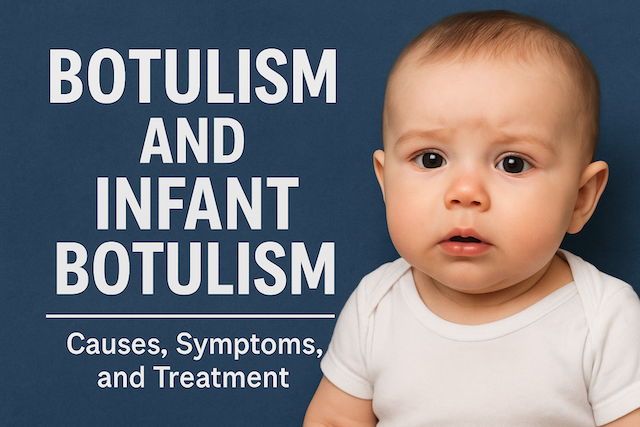Stay updated on what is trending in health. Discover tips and resources for a healthier, balanced life.
Botulism and Infant Botulism: Causes, Symptoms & Treatment
Botulism and infant botulism explained: causes, symptoms, treatment, prevention, how spores affect infants, early warning signs and when to seek urgent care.
DISEASES AND CONDITIONS
Dr. S. Ali
11/11/20256 min read


Botulism is one of the most serious yet rare forms of foodborne and toxin-related illness. Although uncommon, it can be life-threatening without prompt treatment. Among the different types of botulism, infant botulism is the most frequent in many countries — and often the least understood by parents.
This guide explains what botulism is, how it develops, early warning signs, why infants are particularly vulnerable, and how you can prevent it.
What Is Botulism?
Botulism is a rare but dangerous illness caused by botulinum toxin, produced by the bacterium Clostridium botulinum. This toxin blocks nerve function, leading to muscle paralysis that can affect breathing, swallowing, and movement.
Types of Botulism
There are several forms:
Foodborne botulism – from eating foods contaminated with botulinum toxin.
Infant botulism – from ingesting spores that grow inside a baby’s intestines and produce toxin.
Wound botulism – from toxins produced in infected wounds.
Iatrogenic botulism – from accidental overdose of botulinum toxin injections.
Adult intestinal colonization – similar to infant botulism but in rare cases in adults.
Botulism is considered a medical emergency and requires immediate care.
What Causes Botulism?
Botulinum spores are common in soil, dust, and improperly processed foods. The spores themselves are harmless until they grow and produce toxin under low-oxygen, warm, moist conditions.
High-risk sources include:
Improperly canned foods (especially home-canned)
Low-acid foods: green beans, corn, beets, asparagus
Fermented or preserved fish
Foil-wrapped baked potatoes kept at room temperature
Garlic or herbs stored in oil without proper refrigeration
Vacuum-packed or airtight foods
The toxin is destroyed by heat, but spores can survive boiling.
Symptoms of Botulism in Adults
Symptoms typically appear 6 hours to 10 days after exposure.
Early symptoms:
Nausea and vomiting
This often occurs soon after toxin exposure as the digestive system reacts to the contaminated food. It may be mild at first but can worsen rapidly.Abdominal pain
Cramping or discomfort in the stomach may develop as the intestines respond to the toxin. This is usually one of the earliest physical clues.Dry mouth
Botulinum toxin affects the nerves that control saliva production, so many patients notice unusually dry mouth or difficulty producing saliva.Difficulty swallowing
Early involvement of throat muscles can make swallowing feel slow or effortful. This may progress as the toxin affects more nerves.
Neurological Symptoms
Blurred or double vision
The toxin weakens the eye muscles, making it hard to focus. What begins as blurry vision can quickly progress to double vision.Drooping eyelids
When the eyelid muscles weaken, the lids may sag or partially close, sometimes affecting both eyes. This is a classic early neurological sign.Slurred speech
Weakness of the tongue and facial muscles causes speech to sound slow, thick, or unclear. Some people may feel like they “can’t get words out properly.”Facial weakness
The face may appear expressionless or feel heavy. Smiling, blinking, or raising the eyebrows can become difficult.Difficulty breathing
As chest muscles weaken, breathing becomes shallow or labored. This is a medical emergency and requires immediate care.Progressive paralysis
Weakness gradually spreads downward through the body as more nerves are affected. Without treatment, this can lead to life-threatening complications.
Botulism does not cause fever.
Without prompt antitoxin treatment, symptoms may worsen quickly.
Infant Botulism: What Parents Need to Know
Infant botulism occurs when a baby ingests Clostridium botulinum spores, which then grow and produce toxin inside the intestines. Infants under 12 months are at highest risk because their gut microbiome is not yet mature enough to prevent bacterial growth.
It is the most common form of botulism, and parents often miss the early signs.
Causes of Infant Botulism
The two main sources are:
1. Environmental Exposure (most common)
Spores in:
household dust
soil
airborne particles
contaminated surfaces
Even very clean homes can still contain spores.
2. Honey (well-documented source)
Honey and corn syrup can contain botulinum spores.
This is why babies under one year should NEVER be given honey — not even in small amounts or as part of baked goods.
How the Toxin Enters an Infant’s Body
In infant botulism, the danger comes not from the toxin itself, but from botulinum spores that enter the baby’s digestive system. Unlike older children and adults — who have mature gut bacteria that prevent these spores from growing — an infant’s intestines provide the perfect environment for the spores to germinate, multiply, and produce toxin inside the gut.
Once the spores begin producing toxin, it is absorbed through the intestinal lining, enters the bloodstream, and starts blocking nerve signals throughout the body. This leads to the gradual muscle weakness, feeding difficulty, and breathing problems seen in infant botulism.
In other words, the illness develops from inside the baby’s intestines, not from contaminated food in the usual sense — which is why even tiny amounts of spores from dust or honey can cause serious illness in infants.
Symptoms of Infant Botulism
Symptoms usually develop gradually.
Early Signs of Infant Botulism
Constipation (often the first symptom)
This is usually the earliest warning sign, as the toxin slows down the baby’s intestinal muscles.Poor feeding
The baby may struggle to suck or latch, take longer to finish a bottle, or show less interest in feeding.Excessive drooling
Weak mouth and throat muscles make it harder to swallow saliva, leading to noticeable drooling.Weak cry
Parents often notice the baby’s cry becoming softer, weaker, or less forceful than usual.
Progressive Symptoms
Weakness or floppiness (“floppy baby syndrome”)
The baby may feel unusually limp when picked up due to muscle weakness throughout the body.Trouble swallowing
You may see coughing, gagging, or difficulty managing milk because the throat muscles are affected.Decreased movement
The baby may move less, appear tired, or seem unable to lift their arms or legs as they normally would.Breathing difficulty
As chest muscles weaken, breathing may become shallow, slow, or visibly labored — a medical emergency.Poor head control
The baby may struggle to hold up their head or it may fall forward or backward more easily than before.
Infant botulism can be life-threatening, but recovery is excellent with early medical care.
Diagnosis and Treatment for Botulism
How Botulism Is Diagnosed
Doctors may use:
Clinical examination
Toxin testing
Stool or food sample analysis
Nerve function studies (in some cases)
Botulism is often diagnosed based on symptoms because waiting for tests can delay treatment.
Treatment Options
Antitoxin
Adults: Botulism Antitoxin (BAT)
Infants: BabyBIG (Botulism Immune Globulin Intravenous)
BAT and BabyBIG are life-saving antitoxins that stop the botulism toxin from causing further nerve damage. Adults receive BAT, while infants are treated with BabyBIG, a specialized immune therapy designed uniquely for babies. These neutralize circulating toxin and prevent further nerve damage.
Supportive Care
Many patients need:
Hospitalization
Breathing support (ventilator)
Feeding support
Nerve recovery takes time — weeks to months.
Prevention: How to Protect Yourself and Your Baby
Food Safety Tips
Avoid eating or serving foods from swollen, bulging, or leaking cans.
Follow proper pressure-canning guidelines when preparing home-canned foods.
Refrigerate leftovers promptly.
Do not eat baked potatoes wrapped in foil if left at room temperature.
Keep garlic-in-oil mixtures refrigerated.
Infant Safety Rules
Never give honey to a baby under one year.
Avoid exposure to soil and dust sources when possible.
FAQs About Botulism and Infant Botulism
Is botulism contagious?
No — it does not spread from person to person.
Can adults get botulism from honey?
No — adult digestive systems neutralize the spores.
Can infant botulism be fatal?
It can be, but with early treatment, recovery rates are extremely high.
Does cooking destroy botulism toxin?
Yes — heating to 85°C (185°F) for 5 minutes destroys the toxin but not the spores.
When to Seek Immediate Medical Care
Get urgent help if you or your child experiences:
Sudden weakness
A rapid loss of strength in the face, arms, or legs can signal nerve involvement and should be treated as an emergency
Difficulty swallowing
If you or your child struggles to swallow food, liquids, or even saliva, it may indicate early paralysis of the throat muscles.
Blurred vision
Double vision, trouble focusing, or drooping eyelids are key warning signs of botulism affecting the eye muscles.
Trouble breathing
Shallow, slow, or visibly strained breathing can progress quickly and requires immediate medical attention.
Floppiness or poor feeding in a baby
A baby who suddenly becomes limp, struggles to feed, or tires easily while sucking could be developing infant botulism.
Acting quickly improves outcomes dramatically.
Final Thoughts
Botulism is rare, but awareness saves lives — especially when it comes to infant botulism. Knowing the symptoms, avoiding honey for infants, practicing smart food safety, and seeking immediate medical care at the first sign of paralysis or breathing difficulty can make all the difference.
Sources:
CDC – Botulism Overview
https://www.cdc.gov/botulism/index.html
CDC – Infant Botulism
https://www.cdc.gov/botulism/infant-botulism.html
CDC – Botulism Antitoxin (BAT)
https://www.cdc.gov/botulism/health-professionals.html
California Department of Public Health – BabyBIG Program
https://www.infantbotulism.org/
World Health Organization – Botulism Fact Sheet
https://www.who.int/news-room/fact-sheets/detail/botulism
MedlinePlus – Botulism
https://medlineplus.gov/botulism.html
Mayo Clinic – Botulism
https://www.mayoclinic.org/diseases-conditions/botulism
American Academy of Pediatrics – Infant Botulism
https://www.healthychildren.org/English/health-issues/conditions/infections/Pages/Botulism.aspx
Merck Manual – Botulism
https://www.merckmanuals.com/home/infections/anaerobic-bacteria/botulism
Johns Hopkins Medicine – Botulism
https://www.hopkinsmedicine.org/health/conditions-and-diseases/botulism
Pulse Your Health
Empowering you to achieve your health goals.
Contact
© 2025. All rights reserved.
Disclaimer: The content on this website is for informational purposes only and is not medical advice. Always seek the advice of your physician or other suitably qualified healthcare professional for diagnosis, treatment and your health related needs.
